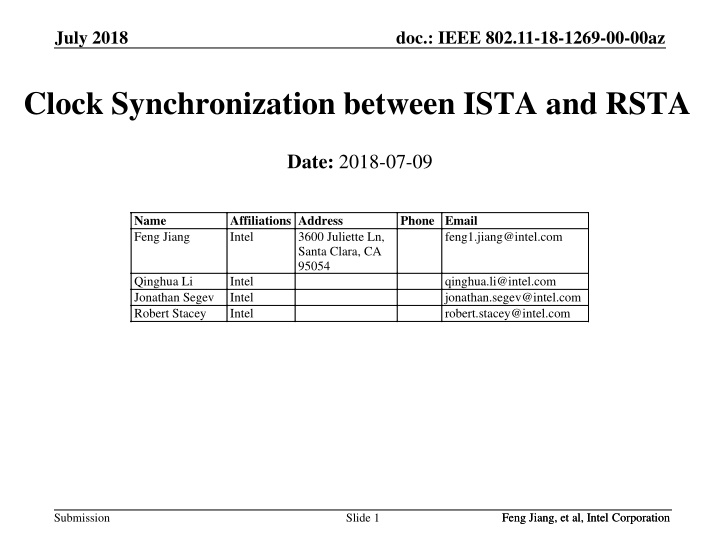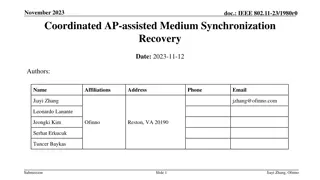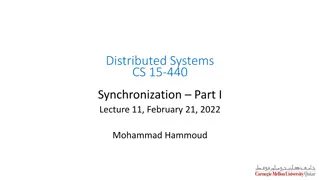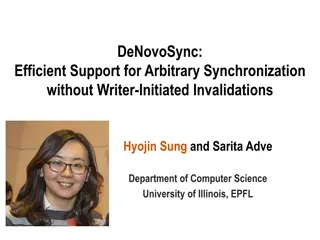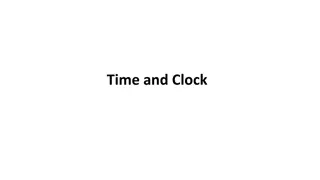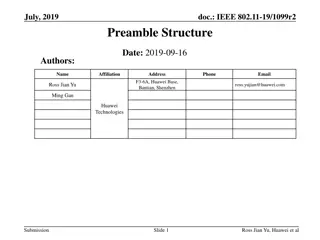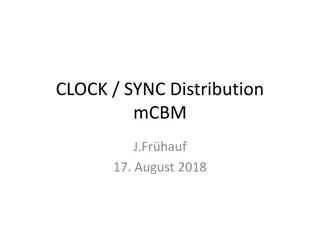IEEE 802.11-18-1269-00-00az Clock Synchronization Investigation
In July 2018, a document was presented by Feng Jiang et al. from Intel Corporation focusing on clock synchronization between ISTA and RSTA in IEEE 802.11-18-1269-00-00az standard. The document delves into the impact of sampling clock errors on range estimation, carrier frequency synchronization in 11ax, and the intuition behind clock synchronization between ISTA and RSTA. It also discusses the HEz measurement sequence and compensation methods for carrier frequency and sampling clock frequency. Detailed insights are provided on clock drift, time drift, frequency offsets, and their effects on round-trip time errors.
Uploaded on Sep 20, 2024 | 4 Views
Download Presentation

Please find below an Image/Link to download the presentation.
The content on the website is provided AS IS for your information and personal use only. It may not be sold, licensed, or shared on other websites without obtaining consent from the author.If you encounter any issues during the download, it is possible that the publisher has removed the file from their server.
You are allowed to download the files provided on this website for personal or commercial use, subject to the condition that they are used lawfully. All files are the property of their respective owners.
The content on the website is provided AS IS for your information and personal use only. It may not be sold, licensed, or shared on other websites without obtaining consent from the author.
E N D
Presentation Transcript
July 2018 doc.: IEEE 802.11-18-1269-00-00az Clock Synchronization between ISTA and RSTA Date: 2018-07-09 Name Feng Jiang Affiliations Address Intel Phone Email 3600 Juliette Ln, Santa Clara, CA 95054 feng1.jiang@intel.com Qinghua Li Jonathan Segev Robert Stacey Intel Intel Intel qinghua.li@intel.com jonathan.segev@intel.com robert.stacey@intel.com Feng Jiang, et al, Intel Corporation Feng Jiang, et al, Intel Corporation Submission Slide 1
July 2018 doc.: IEEE 802.11-18-1269-00-00az Introduction In 11az, the ToA/ToD is estimated based on ISTA s UL NDP and RSTA s DL NDP The ISTA and RSTA use its own sampling clock to calculate ToA/ToD ISTA s or RSTA s sampling clock error is translated to the range estimation error through ToA/ToD It s necessary to investigate the ISTA s and RSTA s sampling clock error s impact on the range estimation Feng Jiang, et al, Intel Corporation Feng Jiang, et al, Intel Corporation Submission 2
July 2018 doc.: IEEE 802.11-18-1269-00-00az 11ax Carrier Frequency Synchronization Transmit center frequency and the symbol clock frequency for all transmit antennas and frequency segments shall be derived from the same reference oscillator (11ax spec) The symbol clock frequency and transmit center frequency maximum tolerance shall be 20 ppm in 5 GHz and 25 ppm in 2.4 GHz A STA that transmits an HE TB PPDU compensates for carrier frequency offset (CFO) error and symbol clock error. After compensation, the residual CFO error (90%) with respect to the Trigger frame shall not exceed 350 Hz (AWGN, -60dBm) Feng Jiang, et al, Intel Corporation Feng Jiang, et al, Intel Corporation Submission 3
July 2018 doc.: IEEE 802.11-18-1269-00-00az Intuition for Clock Synchronization ISTA, RSTA LO drift (10ppm, 10ppm), time drift between t2 and t3 is cancelled with drift between t1 and t4 (reduced RTT error) ISTA, RSTA LO drift (10ppm,-10ppm), time drift between t2 and t3 is added with drift between t1 and t4 (increased RTT error) t1 and t4 are measured using the RSTA s clock (i.e., without applying any frequency offset correction to the time bases). At ISTA the mechanism for tuning t1 and t4 is implementation dependent Feng Jiang, et al, Intel Corporation Feng Jiang, et al, Intel Corporation Submission 4
July 2018 doc.: IEEE 802.11-18-1269-00-00az HEz Measurement Sequence When ISTA transmits UL NDP, the carrier frequency and sampling clock frequency are compensated based on TF The compensation can be easily done in digital domain (phase rotation, sample shift) Or the ISTA can directly tune the local oscillator (LO) Feng Jiang, et al, Intel Corporation Feng Jiang, et al, Intel Corporation Submission 5
July 2018 doc.: IEEE 802.11-18-1269-00-00az Benefit of Clock Synchronization Assume ISTA s LO drift is ?? and RSTA s LO drift is ??, and the real time stamp is t1 , t2 , t3 , and t4 , and real round trip time is RTT The estimated RTT is calculated as: RTT = (t4 - t1) - (t3 - t2) = (t4 - t1 )(1 + ??) - (t3 - t2 ) (1 + ??) = (t4 - t1 ) - (t3 - t2 ) + (t4 - t1 ) ?? - (t3 - t2 ) ?? = (t4 - t1 ) - (t3 - t2 ) + (t4 - t1 ) (?? + ) - (t3 - t2 ) ?? = (t4 - t1 ) - (t3 - t2 ) + [(t4 - t1 ) - (t3 - t2 )]?? + (t4 - t1 ) = RTT (1 + ??) + (t4 - t1 ) In the above derivation, we assume that ?? = ?? + If ISTA s clock and RSTA s clock are synchronized, then becomes 0, and the estimated RTT is RTT = RTT (1+??) Feng Jiang, et al, Intel Corporation Feng Jiang, et al, Intel Corporation Submission 6
July 2018 doc.: IEEE 802.11-18-1269-00-00az Methods for Clock Synchronization ISTA compensates the carrier frequency and sampling clock in digital domain After receiving RSTA2ISTA LMR, the ISTA can use CFO estimation of TF to compensate t3 - t2 RSTA can estimate residual CFO based on pre-compensated UL NDP o Can t reflect the absolute CFO between ISTA and RSTA If RSTA solicits ISTA2RSTA LMR, the LMR can include CFO value o RSTA can combine the residual CFO and the CFO feedback from LMR o Based on the CFO, RSTA can tune t4 - t1 ISTA directly tunes the LO based on CFO After tuning, the ISTA s LO is synchronized with RSTA s LO The t1 and t4 are calculated using the ISTA s synchronized LO o No need to include CFO in ISTA2RSTA LMR Difficult for implementation Feng Jiang, et al, Intel Corporation Feng Jiang, et al, Intel Corporation Submission 7
July 2018 doc.: IEEE 802.11-18-1269-00-00az Design Consideration for VHTz VHTz utilizes HE SU NDP for UL/DL channel sounding Now there is no requirement regarding the carrier frequency and sampling clock frequency synchronization between UL/DL NDP For implementation simplicity, RSTA doesn t need to compensate the carrier frequency and sampling clock frequency of DL NDP The ISTA and RSTA can estimate CFO using preamble of UL/DL NDPs Whether or not to tune t4 - t1 or t3 - t2 is implementation dependent Since in general RSTA is not required to record the ISTA s CFO, the ISTA can include a CFO feedback in ISTA2RSTA LMR. The ISTA or RSTA may exchange their LO quality information in negotiation If ISTA or RSTA chooses to tune time stamps, the LO with higher accuracy should be used as reference Feng Jiang, et al, Intel Corporation Feng Jiang, et al, Intel Corporation Submission 8
July 2018 doc.: IEEE 802.11-18-1269-00-00az Straw Poll #1 In HEz and VHTz ISTA2RSTA LMR, do you support that The ISTA2RSTA LMR shall include a CFO feedback, Based on the CFO feedback, RSTA can tune t4, t1 Y: N: Abstain: Feng Jiang, et al, Intel Corporation Feng Jiang, et al, Intel Corporation Submission 9
July 2018 doc.: IEEE 802.11-18-1269-00-00az Motion #1 We agree that in HEz and VHTz ISTA2RSTA LMR The ISTA2RSTA LMR shall include a CFO feedback, Based on the CFO feedback, RSTA can tune t4, t1 Y: N: Abstain: Feng Jiang, et al, Intel Corporation Feng Jiang, et al, Intel Corporation Submission 10
